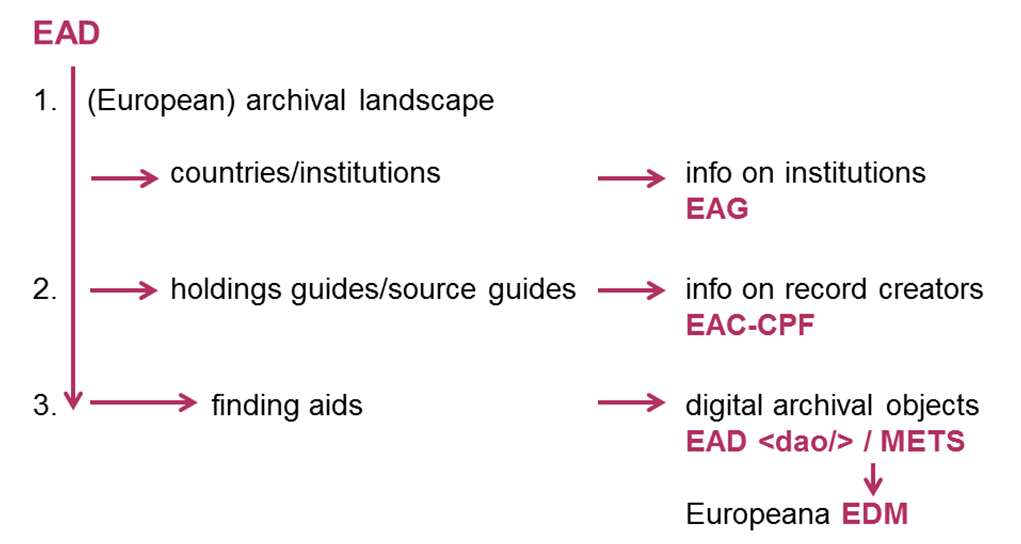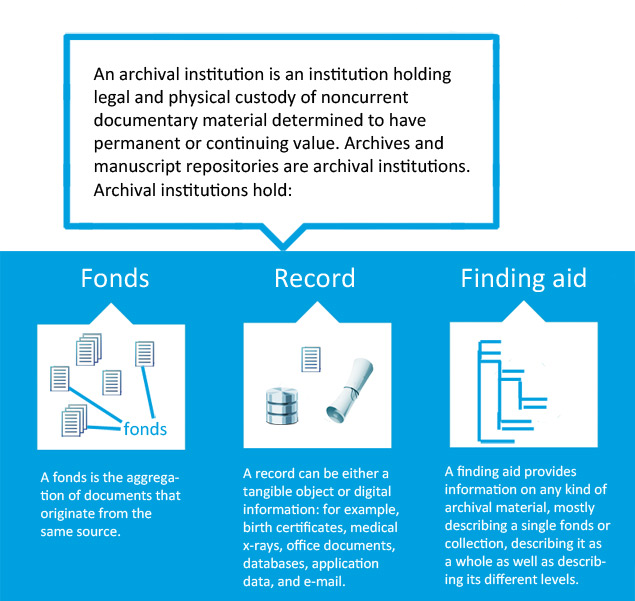Difference between revisions of "Concept Archives Portal Europe"
(→three layer model) |
|||
| Line 7: | Line 7: | ||
The portal fosters the use of internationally accepted archival metadata standards, such as [http://www.loc.gove/ead EAD] en [http://eac.staatsbibliothek-berlin.de EAC-CPF], and has defined a workflow based on standardising the use of these standards. All that is asked from content providers is that they provide their metadata according to these standards, but they will not be foreced to change the way they use these standards: the Archives Portal Europe technical team has developed implementation guidelines for each of those standards, based on a comparison of the best practices of the participating archival institutions, so in fact it has established a common denominator for each standard. This was necessary to be able to publish all metadata from all countries and all institutions, with small standards implementation differences, as consistent as possible. This standardisation of the use of standards has been taken care of by providing mapping stylesheets, which convert any local standards implementation into the common formats used by the Archives Portal Europe. More on the use of the international archival standards by the Archives Portal Europe can be found in the [[:Category:Standards|Standards section]] of this Wiki. | The portal fosters the use of internationally accepted archival metadata standards, such as [http://www.loc.gove/ead EAD] en [http://eac.staatsbibliothek-berlin.de EAC-CPF], and has defined a workflow based on standardising the use of these standards. All that is asked from content providers is that they provide their metadata according to these standards, but they will not be foreced to change the way they use these standards: the Archives Portal Europe technical team has developed implementation guidelines for each of those standards, based on a comparison of the best practices of the participating archival institutions, so in fact it has established a common denominator for each standard. This was necessary to be able to publish all metadata from all countries and all institutions, with small standards implementation differences, as consistent as possible. This standardisation of the use of standards has been taken care of by providing mapping stylesheets, which convert any local standards implementation into the common formats used by the Archives Portal Europe. More on the use of the international archival standards by the Archives Portal Europe can be found in the [[:Category:Standards|Standards section]] of this Wiki. | ||
| − | == three layer model == | + | == combining standards in a three layer model == |
Here is how we connect all the standards we use into the three layer model which is the basis of the Archives Portal Europe framework: | Here is how we connect all the standards we use into the three layer model which is the basis of the Archives Portal Europe framework: | ||
Revision as of 08:36, 25 July 2018
This page explains the concept and the principles on which the Archives Portal Europe is based.
storage of metdata and links to digital objects
The Archives Portal Europe collects and stores only metadata (finding aids), not digital archival objects. Those remain on the storage facilities of the individual archival institutions, the content providers, and the portal links back to them in case the metadata it receives (finding aids) contain links to those digital archival objects.
use of international archival standards
The portal fosters the use of internationally accepted archival metadata standards, such as EAD en EAC-CPF, and has defined a workflow based on standardising the use of these standards. All that is asked from content providers is that they provide their metadata according to these standards, but they will not be foreced to change the way they use these standards: the Archives Portal Europe technical team has developed implementation guidelines for each of those standards, based on a comparison of the best practices of the participating archival institutions, so in fact it has established a common denominator for each standard. This was necessary to be able to publish all metadata from all countries and all institutions, with small standards implementation differences, as consistent as possible. This standardisation of the use of standards has been taken care of by providing mapping stylesheets, which convert any local standards implementation into the common formats used by the Archives Portal Europe. More on the use of the international archival standards by the Archives Portal Europe can be found in the Standards section of this Wiki.
combining standards in a three layer model
Here is how we connect all the standards we use into the three layer model which is the basis of the Archives Portal Europe framework:
We use EAD to come up with an Archival Landscape, hierarchically giving access to all contributing countries and institutions, as well as to their holdings guides, sources guides and finding aids. These EAD documents contain our most important metadata.
For information on the archival institutions we use the EAG standard.
For the description of record creators, we use the EAC-CPF standard and we also give access to this information on the level of the holdings guides, the source guides and the finding aids.
To link descriptions of archival material to digital archival objects, the EAD element <dao/> can be used as well as the METS standard (see for the use of METS in the Archives Portal Europe, the METS section of this Wiki).
And of course - a an aggregator for Europeana - it is possible to forward via the Archives Portal Europe's Dashboard all information on digital archival objects to Europeana by extracting all relevant context information on digital archival objects (if they are available) from the finding aids and convert this information, including the link to the digital archival object, to the Europeana Data Model format (EDM).
Some explanation:
- a holdings guide might be a simple sum-up of all finding aids of an archival institution, so is in fact a simple finding aid that presents all material held in an archival institution, with or without reference to the individual finding aids (for institutions that don't have finding aids in EAD yet, this might be a first start to contribute content to the Archives Portal Europe, because the Dashboard contains functionality to create such a simple holdings guide, which is demonstrated in this short instruction video).
- a source guide or thematic guide is a special type of holdings guide, in which all archival descriptions on a specific theme or topic are gathered, independent of the location where that specific archival material is stored.
- a finding aid is a description of the content of one archival fonds or collection, held by an archival institution.
content provider in full control
So how does this concept of using standardised standards actually work and isn't this too technical and too complicated for content providers? No, the Archives Portal Europe team has put a lot of effort in making contributing to the portal as easy as possible, by implementing a full automatic workflow.
The Archives Portal Europe team takes care of implementing the Archival Landscape in EAD, including a definition of countries and institutions that are willing to contribute.
The contributing archival institutions can provide their data according to their own standards implementations and the Archives Portal Europe team takes care of a mapping or conversion stylesheet towards the Archives Portal Europe standards and makes those stylesheets available in the portal’s back-end, which we call the Dashboard, to which each contributing archival institution will get access.
So after an initial configuring phase the archival institutions can start uploading and publishing their data in the portal’s Dashboard themselves. In order to have content visible in the front-end of the Archives Portal Europe only providing EAG information once and uploading and managing EAD finding aids on a regular basis is mandatory. Everything else, such as providing Holdings Guides and Source Guides and forwarding information on digital archival objects to Europeana, is optional.
So the Archives Portal Europe is not a so called "dark aggregator", nor is its framework a "big black box". On the contrary: by contributing to the Archives Portal Europe content providers to stay in control over their data at all times and at the same time making contributing content to the portal as easy as possible by
Because of this transparency the Archives Portal Europe team also provides the functionality of the portal’s Dashboard as a “Data Preparation Tool” that can be downloaded and used on any stand-alone computer system. Using this tool enables institutions to test their data locally before deciding to use the portal. The outcome of such tests can give the Archives Portal Europe team a headstart in case they have to come up with fine-tuning of the general mapping or conversion stylesheets for these institutions.
Take a look at this short instruction video to see how easy it is to contribute content to the Archives Portal Europe, especially in case this can be combined with automatic OAI-PMH harvesting of content which can be easily configured as you can see in this short instruction video.

